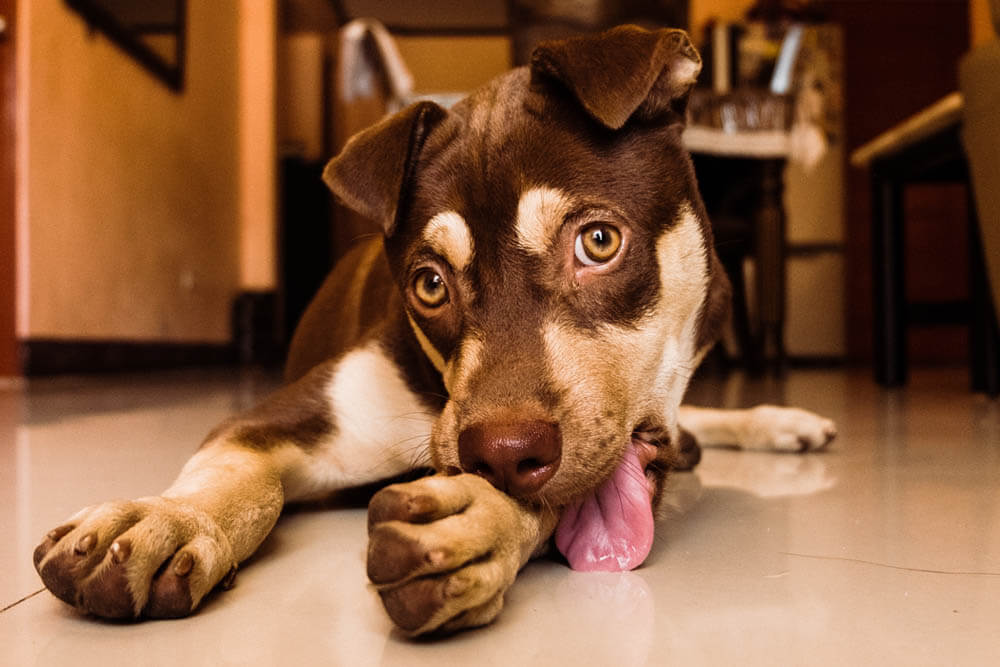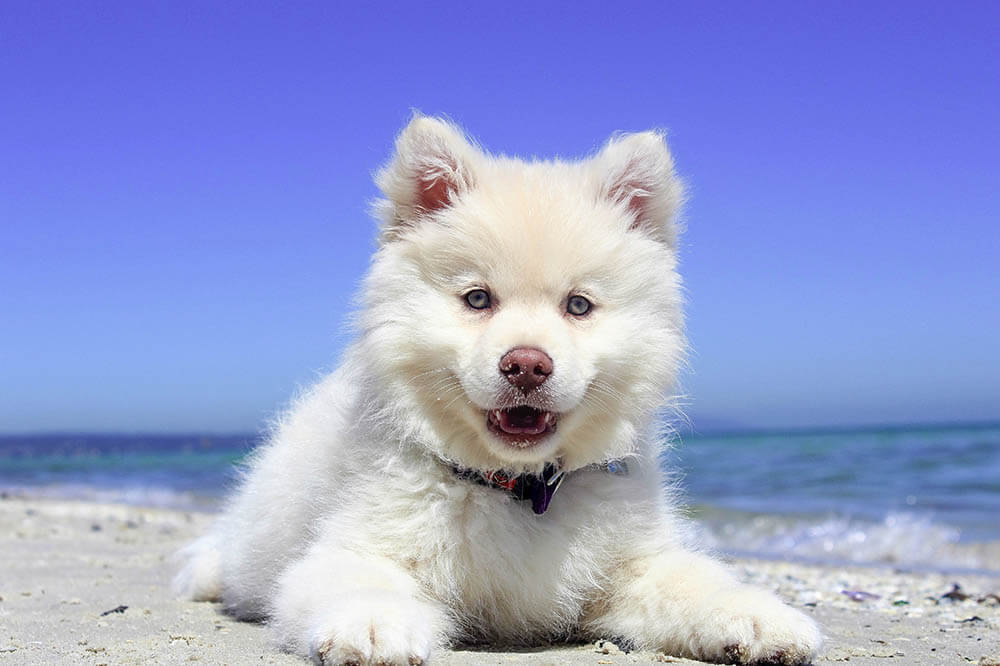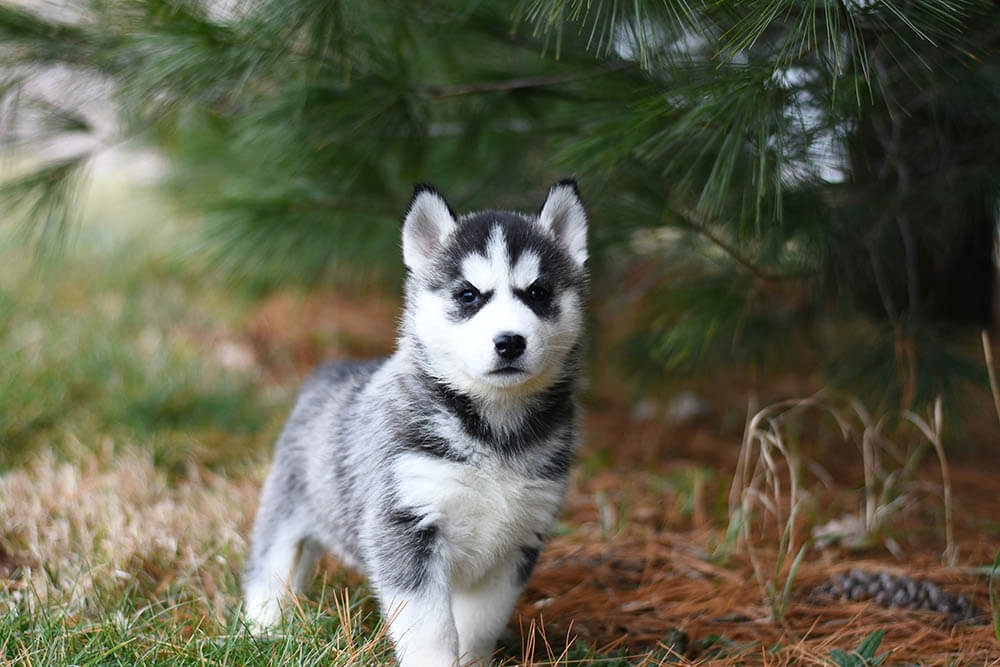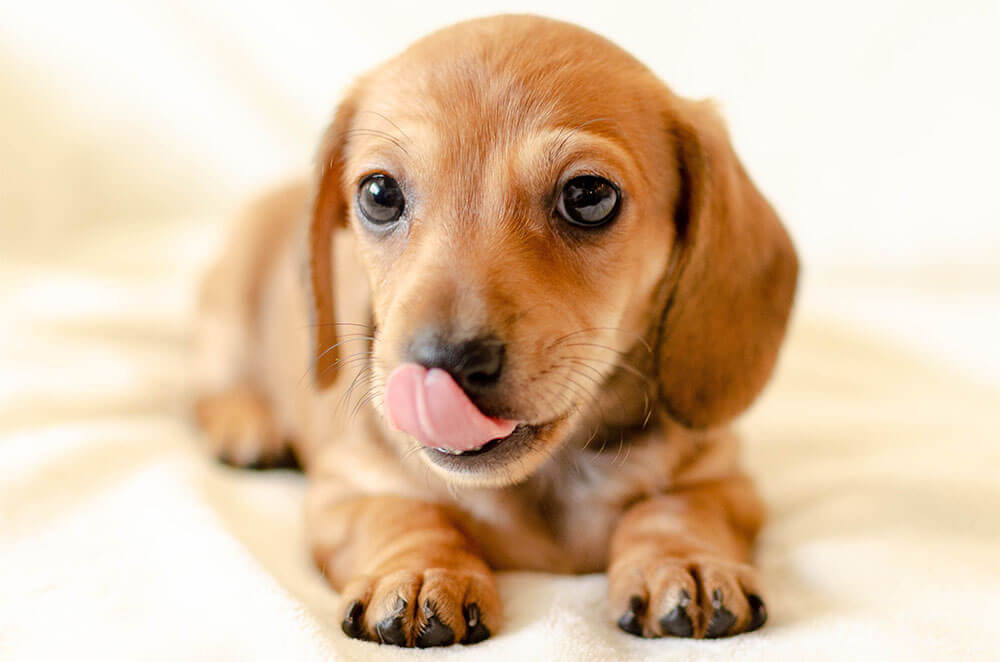Rawhide bones have quite the questionable reputation in the pet-loving community. While many dogs don’t experience problems eating them, veterinarians generally don’t think they’re good for our canine pals.
So, can puppies have rawhide?
Technically, yes, puppies can have rawhide. However, we don’t recommend giving your young pet this chew. As rawhide isn’t easily digestible, it can choke your dog or block their stomach, both of which can be deadly. And those are just two of the problems this chewable can cause.
With that in mind, let’s dive deeper into why puppies are better off not having rawhide.

What is Rawhide?
Rawhide chews are long-lasting treats, usually shaped like a bone, that are given to dogs to keep them entertained.
We create these chews from the inner layer of the skin of creatures such as horses, cows, and occasionally pigs. Leather manufacturers use the animal’s outer skin to create leather; the inner layer, however, can be converted into rawhide bones for our canine friends.
Creating traditional rawhide bones involves stripping the animal hide’s inner portion of tissues such as fat and muscle, then subjecting it to various chemical processes such as cleaning treatments, skin preservation, bleaching, and pressing. Afterward, manufacturers cut the skin into tinier pieces, which they then form into the required shapes and coated in flavoring or coloring agents if necessary. By the time rawhide bones reach pet stores, they no longer resemble the animal hides they came from.
For all these reasons, rawhide bones are highly processed. In addition, some of these items are produced in countries with inadequate safety regulations for dog food.
6 Reasons Why Rawhide is Bad for Puppies
What are the issues consuming rawhide bones can cause a puppy? Let’s find out!
1. Rawhide can cause vomiting, diarrhea, or constipation
The puppy’s digestive system is extremely sensitive and isn’t well-developed enough to properly process rawhide, which even an adult dog can have a tough time digesting. Ingesting rawhide can therefore lead to stomach issues such as diarrhea or vomiting. And if it expands in the tummy, it can cause constipation… or worse. Which brings us to the next point.
2. Rawhide can cause intestinal obstruction
The worst thing poorly digested rawhide can do is partially or completely block your puppy’s gut. This issue can lead to several complications. For one, it can prevent food and water from passing through the animal’s gastrointestinal tract. It can also cut off the blood flow to the affected portion of the gut, causing tissue death that can then result in gut perforation and infection.
Intestinal obstruction is a potentially life-threatening problem that often requires surgical removal.
3. Rawhide can cause choking
Rawhide chews are a choking hazard for dogs – especially tiny ones such as puppies and small-breed dogs. Such chews are not only hard but also sticky when mixed with saliva; if a dog bites off a sizable chunk and attempts to swallow it, it can obstruct the throat and prevent the passage of air through the airways. As you can imagine, this can immediately devolve into a life-or-death situation for a puppy.
4. Rawhide contains chemicals
As discussed in the previous section, the production of rawhide involves the use of various chemicals, including those used to clean, preserve, bleach, and color animal hide. Some of these chemicals are harsh; if ingested, they may cause a puppy an allergic reaction or other serious concerns.
5. Rawhide may contain harmful microorganisms
Because rawhide is made from animal hide, it may be contaminated with illness-causing bacteria such as E. coli and Salmonella. Also, keep in mind that most rawhide treats are manufactured in countries with lower dog food safety standards.
Rawhide chews aren’t meant to be eaten in one sitting; as such, they can last for weeks or even months. And the longer they’re left out in the open, the more likely they are to attract bacteria and disease-carrying creatures such as flies, roaches, and rats. Therefore, your pup could end up licking and eating something that can make them ill.
6. Rawhide can increase your dog’s thirst
Rawhide can make a puppy extremely thirsty, encouraging them to drink an overabundance of water. This can make potty training more challenging.

How a Puppy’s Chewing Style Can Make Rawhide More or Less Dangerous
Like people, not all dogs are the same, with factors such as breed and age influencing distinctions in behavior.
Chewing style is among the many behaviors that differ per dog. Rottweilers, for instance, tend to be stronger, heavier chewers than Chihuahuas. Similarly, due to having softer mouths, young and elderly dogs chew more weakly than those in their prime.
Chewing style matters because how a puppy chews their treats and toys can determine how safe such items are for them. Therefore, what’s suitable for one dog may be inappropriate for another.
Designed to last a long time, rawhide bones are meant to be gradually broken down into soft, small pieces. However, strong chewers can and typically do tear off enormous chunks from their rawhide treats. When swallowed, said chunks can then choke them or obstruct their intestines, resulting in potentially deadly situations requiring immediate treatment. Therefore, it’s best to avoid giving a dog rawhide bones if they have a strong chewing style.
Because soft chewers such as puppies aren’t capable of breaking rawhide treats down into big pieces, they’re at a lower risk of choking or experiencing an intestinal blockage. Keep in mind, however, that some of these items are covered with chemicals that can harm them.
How Rawhide Digestibility Can Harm a Puppy
How easy rawhide is to digest varies per product and per dog.
In general, rawhide is tough to digest, meaning a puppy can’t break it down as efficiently as the other foods they eat. It can even last in the stomach for months to cause myriad problems. This explains why large chunks, when swallowed, increase the risk of intestinal or esophageal obstruction.
Thankfully, some dogs don’t hurry when enjoying their rawhide bones, licking them until they’re soft and only biting off small chunks that they chew thoroughly before swallowing.
In addition, some manufacturers make rawhide products containing more easily digestible ingredients. While these generally don’t last as long as traditional rawhide bones, they’re much safer for dogs, especially those with stomach issues. More digestible rawhide alternatives exist, too (more on this below).

9 Quick Rawhide Safety Tips
Do you want to offer your puppy a rawhide bone? Make sure to observe the following tips to ensure their safety:
1. Give rawhide to older pups only
As younger dogs are more susceptible to experiencing the problems associated with rawhide consumption, wait until your puppy is at least 6 months old before giving them rawhide.
2. Purchase high-quality rawhide only
While they’re more expensive, rawhide chews made in the U.S. are safer for puppies to eat. This is because U.S. rawhide manufacturers must adhere to the country’s strict dog food safety regulations. For similar reasons, only offer your pup rawhide products manufactured by reputable companies.
3. Gradually introduce rawhide to your puppy
When introducing rawhide to your puppy, tear off a few tiny pieces and offer them to your pet one at a time. Before giving them more, wait at least one day to see how their digestive system reacts to the new food.
4. Monitor your puppy
Closely monitor your puppy while they’re chewing on rawhide. Take chewed-up rawhide away from them before they have a chance to consume it. If your pup is a strong chewer with a tendency to tear off large chunks, don’t give them rawhide.
5. Let your puppy chew rawhide for short durations only
The more time your pet spends on this treat, the more opportunities they have to swallow it. Therefore, don’t allow them to spend too much time chewing on rawhide.
6. Take away small rawhide
Once the rawhide is small enough that it can be swallowed whole, take it away from your pup.
7. Separate your puppies
When a puppy is eating while other pets are around, they may feel like those other animals are trying to steal their food, which can encourage them to feed quickly. Thus, only let your puppy chew rawhide when they’re alone. This will help them relax, which will prevent them from rapidly tearing off large pieces and gulping them whole.
8. Keep your puppy’s rawhide clean
To keep your dog free of disease, store rawhide bones where insects and other types of pests can’t access them. Make sure this storage space is clean, too.
9. Consult a veterinarian
Ask a veterinarian how much rawhide your puppy can safely have. In general, the smaller the pup, the smaller the item and the fewer the chews should be.
If your puppy experiences problems after licking or chewing rawhide, contact a veterinarian as soon as possible and listen to any advice they offer. Signs to watch out for include:
- Repeated swallowing
- Gagging
- Regurgitation
- Vomiting
- Diarrhea (bloody or not)
- Lethargy
- Discomfort or pain
- Fever
- Lack or loss of appetite
- Weight loss
- Difficulty defecating
What You Can Give Your Puppy Instead of Rawhide
Manufacturers create many rawhide alternatives using safer, more easily digestible material, making them better for puppies than rawhide bones.
For example, you can give your puppy consumable chew bones. Take note, however, that these can also be broken down into large chunks that a young dog can then swallow. Thus, to prevent choking, supervise your pet while they’re enjoying this treat, and take away from them any big pieces before they can swallow them whole.
Nylon chew bones are another good option. As manufacturers design these items to break apart into tiny, easily digestible ribbons, they’re unlikely to block your puppy’s gut.
You can purchase such alternatives at pet stores. They come in all shapes, sizes, and material compositions, so you can find several that are suitable for your puppy’s age, size, and chew style.

In Conclusion…
While puppies can chew and eat rawhide, they’re much better off not having any. Rawhide is hard to digest and can therefore cause diarrhea, vomiting, constipation, and more serious issues such as choking and bowel obstruction. It may also contain harmful chemicals and dangerous microorganisms. Last but not least, it can increase a puppy’s thirst, making them drink and urinate more often.
Two other factors you should consider include your puppy’s chewing style and the rawhide’s digestibility, both of which can determine how dangerous a rawhide bone is for your pet.
Keep in mind that there are safer alternatives to rawhide chews. But if you insist on having your puppy try rawhide, take all the steps necessary to guarantee their safety.
